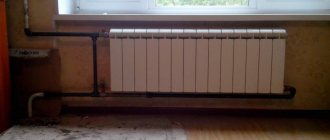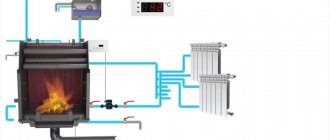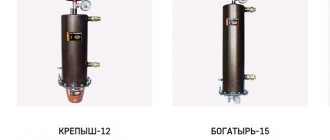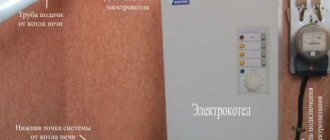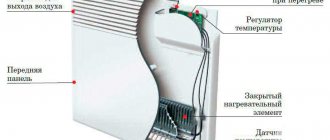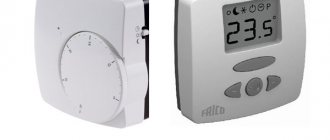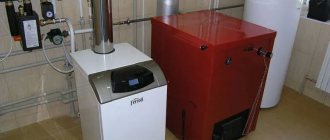Thermostat and thermostat, temperature controller and heat regulator are the names of the same device, the task of which is to maintain a constant temperature set by the user. The thermostat for heating plays a key role, because it is it that ensures the possibility of autonomous operation of the heating system. Also, such devices are often used as part of ventilation systems, air conditioning, automobile engines, and so on.
Types of thermostats for heating
A thermostat, which is what a thermostat is correctly called, is a relatively small but complex device. It is available in several forms: in addition to the classic one, you can choose between digital or wireless. When buying a thermostat, you need to focus on several basic parameters.
These include, in particular, control, type of sensor, location on the wall, and you should also pay attention to its connection to the boiler or other heat source.
- The thermostat should be located in an area where air circulates naturally, so it is not recommended to place it near windows or an air conditioner.
- Ideally, it should be installed at a height of 1.5 meters from the floor. At this height it will be easy to operate, and in the case of a display, all the necessary information will be before your eyes.
There should be no devices nearby that generate heat. The thermostat should not be placed in places where it will be exposed to sunlight. Therefore, a free wall without furniture is suitable for its placement.
Most thermostats are battery operated, but some require a power source. In this case, it is also necessary to provide a cable laying or socket nearby.
What is a smart thermostat
First, let’s define what a smart thermostat is. It is a smart device equipped with humidity, temperature, motion and light detectors. Based on their readings, the device is able to successfully control heating, air conditioning, dehumidifier/humidifier, heat pump and ventilation. Self-learning thermostats have appeared relatively recently.
They are able to monitor the owner’s actions, highlight his preferences regarding the microclimate in the rooms and subsequently maintain the required parameters without human intervention. As we can see, a smart thermostat is complex and expensive equipment. The main factor for the success of its installation is the presence of an appropriate number of actuators installed in the apartment.
The more complex the engineering systems, the higher the feasibility of installing a smart thermostat. Otherwise, it will not meet the owner’s hopes and costs. And one more nuance. Most thermostats are designed to work in autonomous systems, that is, “directly” with heating devices of various types.
Such a device is not suitable for an apartment; there is simply nothing to connect it to. In this case, you need to look for devices adapted to work with a centralized heating system. There are not many of them, but they exist.
Sensor type
The thermostat design always includes a sensor that measures the ambient temperature.
Thermostats are available with:
- Indoor;
- Floor-standing;
- Combined sensor.
Floor sensors are suitable for heated floors, you can use the space if you have any other type of heating.
Combined sensors are used for heated floors, the room sensor here serves as the main sensor, and the floor temperature sensor serves as protection against overheating of the floor.
Thermal valve - structure, purpose, types
The valve in the thermostat is very similar in structure to a regular valve. There is a seat and a shut-off cone that opens/closes the gap for coolant flow. The temperature of the heating radiator is regulated in this way: by the amount of coolant passing through the radiator.
Sectional view of thermostatic valve
The valves are installed differently for one-pipe and two-pipe wiring. The hydraulic resistance of a valve for a one-pipe system is much lower (at least two times) - this is the only way to balance it. You can't mix up the valves - it won't heat. For systems with natural circulation, valves for single-pipe systems are suitable. When installing them, the hydraulic resistance, of course, increases, but the system will be able to work.
Each valve has an arrow indicating the movement of the coolant. During installation, it is installed so that the flow direction coincides with the arrow.
What materials?
The valve body is made of corrosion-resistant metals and is often additionally coated with a protective layer (nickel or chrome plated). There are valves from:
- bronze (nickel and chrome plated);
- brass (coated with a layer of nickel);
- of stainless steel.
It is clear that stainless steel is the best option. It is chemically neutral, does not corrode, and does not react with other metals. But the cost of such valves is high and it is difficult to find them. Bronze and brass valves have approximately the same service life
What is important in this case is the quality of the alloy, and it is carefully monitored by well-known manufacturers. Whether or not to trust unknowns is a controversial issue, but there is one point that is better to track
There must be an arrow on the body indicating the direction of flow. If it is not there, then you have a very cheap product that is better not to buy.
By method of execution
Since radiators are installed in different ways, the valves are made straight (through) and angular. Choose the type that will work best for your system.
Straight (way through) valve and angle
| Name/Company | For which system | Du, mm | Housing material | Operating pressure | Price |
| Danfos, angular RA-G, adjustable | single-pipe | 15 mm, 20 mm | Nickel plated brass | 10 bar | 25-32 $ |
| Danfos, direct RA-G with customizability | single-pipe | 20 mm, 25 mm | Nickel plated brass | 10 bar | 32 — 45 $ |
| Danfos, angular RA-N, adjustable | two-pipe | 15 mm, 20 mm. 25 mm | Nickel plated brass | 10 bar | 30 — 40 $ |
| Danfos, direct RA-N with customizability | two-pipe | 15 mm, 20 mm. 25 mm | Nickel plated brass | 10 bar | 20 — 50 $ |
| BROEN, direct fixed tuning | two-pipe | 15 mm, 20 mm | Nickel plated brass | 10 bar | 8-15 $ |
| BROEN, direct fixed tuning | two-pipe | 15 mm, 20 mm | Nickel plated brass | 10 bar | 8-15 $ |
| BROEN, corner, adjustable | two-pipe | 15 mm, 20 mm | Nickel plated brass | 10 bar | 10-17 $ |
| BROEN, corner, adjustable | two-pipe | 15 mm, 20 mm | Nickel plated brass | 10 bar | 10-17 $ |
| BROEN, direct fixed tuning | single-pipe | 15 mm, 20 mm | Nickel plated brass | 10 bar | 19-23 $ |
| BROEN, fixed angle | single-pipe | 15 mm, 20 mm | Nickel plated brass | 10 bar | 19-22 $ |
| OVENTROP, axial | 1/2″ | Nickel plated brass, enamel plated | 10 bar | 140 $ |
Options for connecting thermostats
Temperature controllers are divided into wired and wireless. The wireless device consists of two units, the first is a separate room thermostat, and the second is a relay. The indoor unit is located in the room, and the relay is located at the heat source; this is a thermostat for the heating radiator.
- Wireless communication between these devices is carried out over a distance of about 30 meters in open space.
- However, this connection can be interrupted by metal objects or devices that are a source of electromagnetic waves.
- A wireless connection is simpler in complexity, but you will have to pay extra for this comfort.
- Wire thermostats have a relay located directly in the thermostat and work on the same principle as wireless ones.
- This type is more difficult to install; the wire must be placed in a rail or wall.
Compatibility with the heat source is also important. You can check whether the boiler can be connected to a thermostat in the documentation for the heat source or consult a specialist.
Is it possible to save on central heating fees?
Theoretically, the answer is yes, but in practice everything is not so simple. Let's assume that you decide to install a smart thermostat with programmable thermostats in your apartment. As a result of equipment operation, resource consumption will be reduced by about a third. This will also depend on the amount of heat loss from the home and other factors. But this fact will not affect the amount in the payment in any way.
The fact is that residents in apartment buildings pay for heating according to so-called standards or according to meter readings. The latter can be individual or communal. In our case, in order to register the fact of reduced resource consumption and, accordingly, reduce heating fees, you will need to install a heat meter in the apartment. This is not always possible.
Sealing and IP protection
Thermostats located in living rooms have a degree of protection IP20. This coating will provide them with protection from the penetration of particles with a diameter of more than 12.5 mm. Usually the outer shell is not protected from water.
- If the thermostat of the heating boiler is planned to be placed in the kitchen or hallway, it must have a degree of protection IP30.
- This lid provides protection against penetration of particles larger than 2.5mm in diameter, and even this box is not waterproof.
When installing a thermostat in a bathroom or toilet, choose IP21 protection, which protects against the penetration of particles with a diameter of more than 12.5 mm, as well as protection against water.
Buy a room thermostat for heating.
We recommend that you buy a thermostat for heating or buy a thermostat for a gas boiler in order to establish home automation as part of controlling the heating system. This will provide comfort, ensure safe operation of the heaters, and reduce energy costs for the operation of heating devices. Installing a regulator will definitely pay off. The best choice is reliable electronic thermostats. There is a wide range of such devices on sale. The price of a heating temperature controller varies. Our online store Teploregulyator.ru has a large selection of climate control devices from various global manufacturers. We deliver products throughout Russia and neighboring countries.
Buying a pump activation regulator is very simple! Call us for advice on choosing products, as well as assistance in placing an order.
Relay load
The maximum load of the thermostat is limited by the maximum load of the output relay. Typically this is around 16 A. To prevent unwanted overloading of the device, a margin of approximately 10% is required.
If the output power of the relay load exceeds the load, additional equipment will need to be purchased and installed in the distribution box.
Water heated floor - pros and cons
Like other heating systems, this one has positive and negative sides. To make a choice, you need to familiarize yourself with them. Water heated floors have the following advantages:
- Significant savings due to heating a large area compared to a radiator system.
- Allows you to heat the entire floor evenly.
- The period of operation is more than 50 years.
- Can be combined with different heating systems.
- There is no dampness or fungus in the house.
- It is possible to adjust the temperature.
- Safety of use of the system.
- Maintenance is not difficult.
Water floor heating also has some disadvantages:
- Cannot be connected to a central heating system.
- There are some difficulties during installation.
- A water pump is required.
- Possibility of leakage.
Functional
The thermostat is intended only for setting the temperature. However, digital, programmable, and smart thermostats offer a number of practical features.
With these thermostats, you have several temperature programs available to you.
Depending on the programming mode, you can select one of the following types:
- 7-day mode - thermostats with this feature allow you to program each day of the week;
- 5-1-1 mode - here you can set one mode for all weekdays and a separate program for Saturday and Sunday;
- Mode 5-2 - in this case you can set the temperature for all working days and one temperature for the weekend.
Other features include:
- Office function that provides savings during workdays;
- Vacation mode will reduce the temperature in the rooms on days when no one is home, which will avoid unnecessary expenses;
- Frost protection mode. In this mode, the thermostat turns on only if the room temperature drops below the set subzero temperature;
- Child lock prevents possible reprogramming of the thermostat.
Purpose of the device
If there is significant overheating, boilers can turn off on their own, because the heating equipment has special regulators for this that respond to changes in the temperature of the coolant in the heat exchanger. But with a rapid increase in temperature and location at some distance from the boiler, they may not work in a timely manner. In such a situation, only local fuses will help. They are special thermostats. They instantly signal the danger of overheating of the batteries (radiators), so there is no need to worry about emergency overheating of the heating elements.
A room thermostat for gas heating with an automatic function eliminates the need to manually adjust the boiler. After all, when heating equipment is turned on and off manually, the water heating function takes a short time - a maximum of 10 minutes. This leads to significant wear and tear on heating equipment.
In operating mode, the boiler heats water, which subsequently circulates through the batteries (radiators). In this situation, the temperature and pressure in the heating equipment may exceed the permissible norm, which will cause a malfunction or accident.
Thermostat cost
The cheapest thermostats are mechanical with manual adjustment. They allow you to set the temperature in the range from 5 to 30 ° C, do not have a display, and are turned on and off with one button.
More advanced models have digital backlighting and a clear display with manual control. These thermostats allow you to set multiple day programs and are also available in a wireless version.
You can buy top-end thermostats with a range of features. They are equipped with a combined sensor. They have several modes and preset programs. They can be connected to a smartphone via Wi-Fi, GSM module.
Let's look at the numbers.
The price of metering devices depends on their type and starts from 7,000 rubles. To this you need to add the cost of obtaining permits and services for installing the device. In addition, you need to remember that the meter is subject to periodic verification and replacement, like any other metering device. The price of a smart thermostat starts from 5,000 rubles without installation.
To this we must add the price of programmable thermostats installed on radiators. This is at least another 3,000 rubles. for each device. Thus, we receive a fairly impressive amount that will be required to implement intelligent heating control in the apartment. The expected savings, according to specialists' calculations, will be about 30% of the existing payment amount.
At the same time, you need to understand that savings will depend not only on the operation of the thermostat, but also on how well the apartment is insulated and whether there are sources of heat leakage. Another important factor. A smart thermostat is designed to control several systems; their presence in the average apartment is highly doubtful. Thus, it is unlikely that it will be possible to use all the capabilities of smart equipment.
As a result, it turns out that the costs of purchasing and installing equipment will be quite large, especially if you choose modern devices from a trustworthy manufacturer. However, it will not be possible to use their full potential. Still, UDs are intended, rather, for houses with autonomous life support systems.
The savings compared to the costs are not that big. Is such a solution viable? It is up to those who want to implement it in their apartment to decide.
Photo of a thermostat for heating
Installation of automatic heating regulators
The instructions below will help you install the thermostat on both aluminum and bimetallic radiators.
If the radiator is connected to a working heating system, then the water should be drained from it. This can be done using a ball valve, shut-off valve or any other device that blocks the flow of water from the common riser.
After this, open the battery valve, located in the area where water enters the system, and turn off all taps.
After the water has been removed from the battery, it must be purged to remove air. This can also be done using a Mayevsky crane
The next step is to remove the adapter. Before the procedure, the floor is covered with material that absorbs moisture well (napkins, towels, soft paper, etc.).
The thermostatic valve body is fixed using an adjustable wrench. At the same time, use a second wrench to unscrew the nuts located on the pipe and the adapter, which is located in the battery itself. Next, unscrew the adapter from the body.
When unscrewing the adapter, you may need to use the valve located inside the battery
After dismantling the old adapter, a new one is installed. To do this, place an adapter in the structure, tighten the nuts and collar, and then thoroughly clean the internal threads using a clean material.
Next, the cleaned thread is wrapped several times with white plumbing tape (purchased separately in specialized stores), after which the adapter, as well as the radiator and corner nuts are tightly screwed on.
The thread must be wrapped with plumbing locking tape clockwise, making 5-6 turns
It is important that the tape lays evenly, so it is necessary to smooth it out in a timely manner if necessary. As soon as the installation of the adapter is completed, you need to begin removing the old collar and installing the new one.
In some cases, it is difficult to remove the collar, so cut out its parts using a screwdriver or a hacksaw, and then tear them off from each other
Once the installation of the adapter is completed, you need to begin removing the old collar and installing the new collar. In some cases, it is difficult to remove the collar, so its parts are cut out with a screwdriver or a hacksaw, and then torn off from each other.
Next comes the installation of the thermostat itself. To do this, following the arrows shown on the body, it is installed on the collar, after which, fixing the valve with an adjustable wrench, tighten the nut, which is located between the regulator and the valve. At the same time, use a second wrench to tighten the nut tightly.
It is important not to damage the thread when installing the thermostat, and after tightening, check the strength of the connection in order to avoid leaks when turning on the water.
At the final stage, you need to open the valve, fill the battery with water, make sure the system is working, there are no leaks, and set a certain temperature. In a two-pipe system, you can install thermostats on the top supply.

